- remind me tomorrow
- remind me next week
- never remind me
The X Button
Stray Game Strut
by Todd Ciolek,

Last week's Nintendo Direct broadcast announced several new games, but none was welcomed as gladly as the news about an old game: Shigesato Itoi's beloved Super NES classic Earthbound will arrive on the Wii U's Virtual Console in North America and Europe “by the end of the year.” Many believed that Nintendo wouldn't release the game in the West due to legal problems with some sampled and similar-sounding music. That apparently poses no problem to Nintendo, though it remains to be seen if they'll alter the questionable tracks or just ignore the legalities entirely.
It's no surprise that Nintendo cited fan demand in its decision to bring the game to the Virtual Console. Earthbound fans are a passionate lot, often driven to verse to express their fondness for the games. One of the earliest examples is this poem from the November 1995 issue of Nintendo Power.

This is far from the limit of Earthbound-inspired art. Among numerous other tributes to the series, Starmen.net features a recording of a devoted lad making his way through a song called “Mother Mother.” You'll find the lyrics posted separately, but they really don't compare to the full performance. It's absolutely adorable.
It's sad that Nintendo still hasn't brought Mother 3 to these shores, which seems to be driving theme of the song. But we'll have Earthbound on the Wii U, and so we'll be happy. Not sad.
NEWS
IN NON-EARTHBOUND NEWS…
Among the other titles shown off in Nintendo Direct were a Luigi-centric remix of Super Mario Bros. U called Super Luigi U, Game & Wario for the Wii U, Mario Party and a port of Donkey Kong Country Returns for the 3DS, and more of the 3DS Luigi-tormenting simulator called Mario & Luigi: Dream Team. Oh, and there's a new breed of Pikmin in the franchise's third game. They have wings.

Nintendo also introduced a new Yoshi's Island game for the 3DS. The stages shown look quite reminiscent of the Super NES game and DS sequel, though the plastic 3-D look of Yoshi and Mario recalls that ill-received Yoshi's Story for the Nintendo 64. Come to think of it, a lot of people didn't like Artoon's Yoshi's Island DS, either. Maybe this'll be different.

So what game from Nintendo Direct is everyone arguing about the most? That'd be the sequel to The Legend of Zelda: A Link to the Past. It's a new story set within the same world as the Super NES original, and it adopts a similar style of 2-D gameplay most of the time. However, it also allows Link to shift into a flat version of himself and inch along walls. Naturally, there's a lot of fan debate over the game's new look, its revival of a classic Zelda game, and just how this might affect that screwy Zelda timeline. If this troubles some Zelda fans, they can head for the underrated Oracle of Ages and Oracle of Seasons games, which will come to the 3DS Virtual Console on May 30. Can a Zelda game really be underrated? Well, I think the Oracle titles qualify.
ALLTYNEX KICKSTARTER UNDERWAY, POSSIBLY WITH BOOK AND PILLOW
Nyu Media's done well to bring independent Japanese games to North America, and now they're on Kickstarter to finish up the ALLTYNEX shooter trilogy and promote it on Steam.
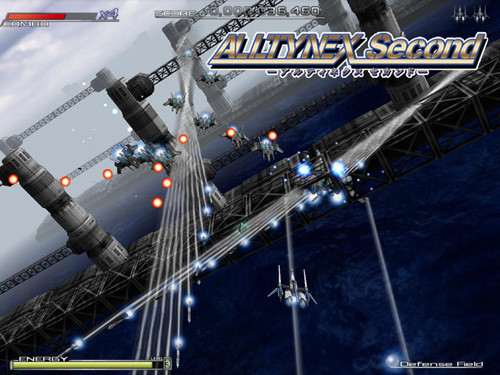
The Tale of ALLTYNEX, as it's called and capitalized, seems a little confusing in its plot connections. The last game story-wise is KAMUI, which developer Siter Skain made back in 1999, and the first game in the saga's chronology is the most recently released and most graphically impressive ALLTYNEX Second (which is a remake of an FM Towns game called ALLTYNEX, but I'll stop there). The important thing is that they're all downright impressive shooters in the vein of Taito's RayForce/Layer Section series. The resemblance is strongest in the late-1990s look of KAMUI, which features an auto-targeting blast and a bullet-eating weapon, while RefleX has a reflective shield. ALLTYNEX Second, the last/first in the series, has a melee-like sword system and the usual homing lasers. In some ways it's a divergent evolution of RayForce; that series turned to prettier 3-D with its sequels RayStorm and RayCrisis, but they didn't have quite the same firm two-dimensional look as the original. The ALLTYNEX shooters have that look.
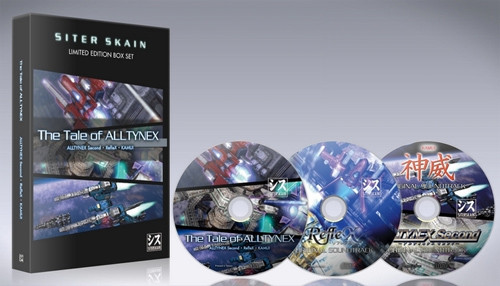
The Kickstarter already passed its goal, and a pledge of $35 or higher still gets you all three shooters. Beyond the $100 mark, the increasingly higher donations might get you t-shirts, a plushie of the Siter Skain mascot Inu Ball, and a (safe-for-work) body-pillow cover depicting KAMUI's heroine Panaffil de Alice, who actually has her brain yanked out and put into a space fighter. If the donations pile up high enough, there'll be ALLTYNEX artbooks and a limited-edition physical DVD release. And it's always nice to see smaller projects get bigger.
FEATURE: LOST ANIME GAMES
One might assume that licensed games are canceled less often than wholly original ones. After all, the name of a movie or a TV series or an anime franchise gives a project more money and recognition, right? Well, that's not really how it works. Licensed games are just as likely to die on the vine as any other game in development, and that's precisely what happened to a number of high-profile anime derivatives.
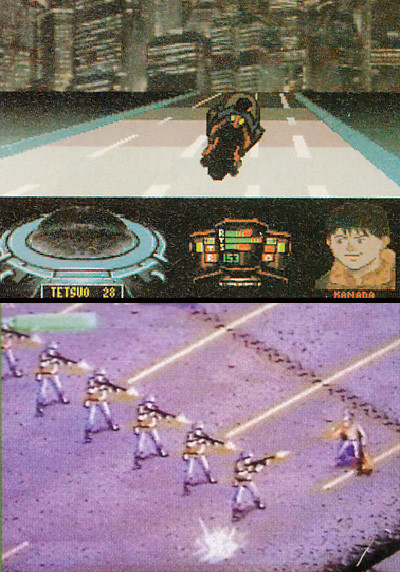
If you bought Akira on VHS back in the 1990s, it might've included a postcard promoting an Akira video game. And you might've wondered why that game never showed up at Toys R Us or Babbage's. Black Pearl Software acquired the video-game rights to the film in the 1990s and immediately set to work on games for just about every system: the Super NES, the Genesis, the Sega CD, and the Game Gear. Even the Game Boy had an Akira title in store (though it was possibly just a touched-up version of an unrelated game). More impressive yet, each system had a different sort of game in mind. The Genesis version mixed together various genres, including racing levels, diagonally viewed stages, and first-person psychic shooting. The Super NES game stuck to side-scrolling and racing. Both looked impressive, but they weren't to be; THQ bought Black Pearl in 1993, and the Akira games didn't survive for long after that.

Osamu Tezuka's Jungle Emperor is notable for having two different games canceled in two different generations. Taito announced a Jungle Emperor game for the Famicom in 1989, apparently envisioning a side-scrolling action title where Leo (or Kimba, as we knew him in the West) enlisted the help of his various animal subjects. The game appeared in magazine spreads and on flyers, but it mysteriously vanished around 1991. It was never announced for an American release, though Taito was certainly willing to visit classic cartoons on the NES—they released Jetsons and Flintstones games, after all.
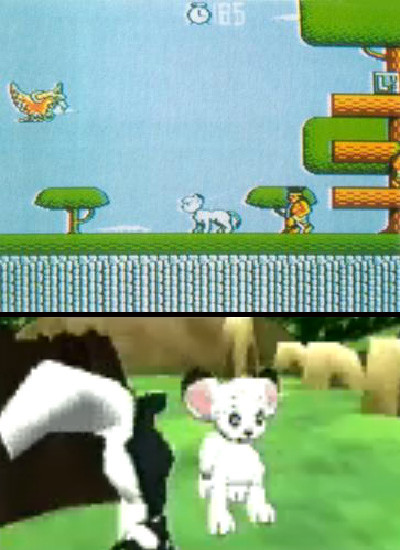
The second lost Jungle Emperor game was far more noticeable in its disappearance. Nintendo announced it for the Nintendo 64 not long after the console's launch, promising a 3-D game where “you also use your heart.” A short demo appeared at the 1998 Shoshinkai exhibition, and Nintendo revealed that the title would be co-developed with Makoto Tezuka (son of Osamu) and his studio. By 1999, however, Nintendo legend Shigeru Miyamoto revealed that the company “could not release it to the market,” and further statements suggest that Tezuka's estate just didn't have time for the Nintendo collaboration.
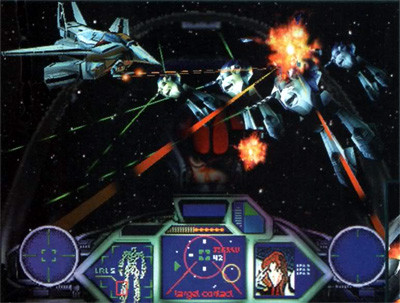
Jungle Emperor wasn't the only anime absence on the Nintendo 64. GameTek's Robotech: Crystal Dreams was perhaps the biggest third-party spectacle in the first wave of games promised for the system. Mock-ups of the game looked amazing, and the extensive hype about the Nintendo 64's graphical acuity had many people believing that the final game would be just as impressive. Most of the early Nintendo 64 came to pass in one less-attractive form or another, but Robotech: Crystal Dreams never arrived. In a 2002 interview with Robotech.com, game designer Doug “Opus” Lanford summed up the game's cancellation with “GameTek was too small a company for this kind of a project.” The publisher shut down in 1998, leaving Crystal Dreams unfinished. All is not lost, however. You can download a beta version of the game from Lanford's site.
Trigun: The Planet Gunsmoke sure sounded great back in 2002. The anime version of Yasuhiro Nightow's Trigun was a smash hit, and its menagerie of cyborg-superhero-wild-west characters seemed perfect for an action game. Sega revealed such a game, a third-person shooter, with a brief trailer that didn't show much beyond the familiar silhouette of Vash the Stampede and an unfamiliar cyber-armed cowpoke. This would be the only public record of The Planet Gunsmoke, as Sega's shown nothing of it since.
The Planet Gunsmoke technically hasn't been canceled, but it was supposed to come out on the PlayStation 2 some ten years ago. Things...uh, things don't look good.

Among more recent anime no-shows, Tecmo's Bastard!! Online was a strange beast. A PC MMORPG based on Kazushi Hagiwara's completely shameless swords-and-sex fantasy manga, the game was first announced in 2005 and apparently reached the beta-testing phase around 2008. Tecmo canceled it the following year, though the site's still up. Perhaps they noticed that there's already no shortage of online games rife with scantily clad warriors.

Some anime-based games are canceled outright, and others are merely canceled in North America and Europe. Ranma ½ inspired several fighting games for Nintendo's 16-bit platform, and they made strange journeys to North America. Irem revamped the first one into an unspeakable mess called Street Combat, but DTMC released the second one on the Super NES as Ranma ½: Hard Battle with far fewer changes. Toho planned to bring out the third under the title Ranma ½: Anything-Goes Martial Arts. Ads were placed and box art was approved, but the game was canceled anyway.
In the early years of the Nintendo Entertainment System, Bandai advertised a game called Zeta Gundam, and the description sounds a lot like Mobile Suit Z Gundam: Hot Scramble for the Famicom. The game would never reach these shores, though Bandai would release other anime-based games with generic makeovers: GeGeGe no Kitaro became Ninja Kid, Obake no Q-Taro became Chubby Cherub, and most notorious was Dragon Ball's transformation into Dragon Power. Perhaps Yoshiyuki Tomino just wouldn't let them overhaul Gundam.
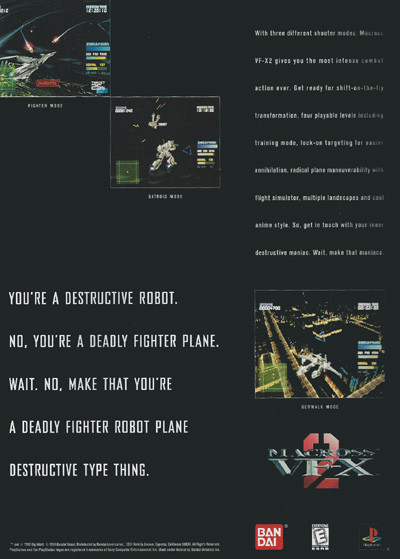
Bandai had more bad luck with another big-name anime license: Macross VFX-2 for the PlayStation. The original Macross VFX was loathed by all who imported it, but Bandai saw promise in the sequel. A U.S. release was advertised for a late 1999 launch, and the game even appeared on a demo disc in the Official U.S. PlayStation Magazine. That was it. Bandai quietly canceled the domestic version of VFX-2 by the end of the year. The publisher gave no official reason, but evidence suggests that the game ran into legal scrapes with Harmony Gold, which barred many other Macross properties from these shores.

This brings us to Cowboy Bebop: Serenade of Remembrance for the PlayStation 2. A 3-D brawler of sorts, the game hit Japan in 2005, and Bandai planned to bring it here by the end of the year. I handled the game coverage for Anime Insider at the time, and of course I kept pestering Bandai about Cowboy Bebop. By the time 2006 rolled around, the game had vanished from release lists, and the nice Bandai reps admitted, diplomatically as they could, that the game wasn't really worth the trouble. While most fans have forgotten about the game itself, it endures in one respect. The infamous newspaper image of “Cowboy Bebop at his computer” uses a screenshot from Serenade of Remembrance.
That's about it for this roundup of anime-based games that the world never saw, though there are many I didn't discuss. There's the U.S. release of Akira Psycho Ball for the PlayStation 2, and that Micro Man Game Boy Color title that never showed up anywhere. And what about the news of a Gundam Wing game that Atari would bring to arcades back in 2001? Was that just a typo, like Cowboy Bebop at his computer?
NEXT WEEK'S RELEASES
DEADLY PREMONITION: THE DIRECTOR'S CUT Developer: Access Games/ToyBox
Developer: Access Games/ToyBoxPublisher: Rising Star Games Platform: PlayStation 3 Release date: April 30 MSRP: $39.99 Deadly Premonition slipped by a lot of people when it arrived on the Xbox three years ago, and I admit that I was one of them. The game actually dated back to 2007, when it was called Rainy Woods and looked like a rather blunt rip-off of Twin Peaks. A lot of us didn't expect much from it, but by 2010 director Hidetaka “SWERY” Suehiro had reworked the game, lessened the similarities to David Lynch's TV series, and stumbled into brilliance. The Deadly Premonition we know still recalls Twin Peaks, particularly in it letting players control FBI Agent Francis York Morgan as he investigates a small-town murder. There is much more to the game, however. York finds his way through the town's lineup of curious characters (and murder suspects), and there's a deliberate, weird, marvelous tone to everything he does as the days pass: keeping his car running with gas or repairs, consuming coffee and improbably good sandwiches to keep up his energy, running irrelevant but compelling errands for the citizens, spying on people in their own homes, flirting with a sheriff's deputy, and talking to a seemingly invisible being named “Zach.” The problem was that Deadly Premonition was still a survival-horror game, so players had to guide York through rather clumsy action sequences that pitted him against shadowy attackers. Most Deadly Premonition fans saw no shame in setting the difficulty level low and enjoying the other parts of the game. It's the sort of thing a director's cut could fix…oh, hey. Deadly Premonition: The Director's Cut promises “reworked” and presumably better controls for the game's combat stages. It also expands the storyline of the original with a new chapter from Swery himself and some vaguely described downloadable extras. GameStop even has an in-game espresso machine with pre-orders, and that's entirely appropriate for Deadly Premonition.
|
THE DENPA MEN 2 Developer: Genius Sonority
Developer: Genius Sonority Publisher: Genius Sonority Platform: Nintendo 3DS (eShop) Release date: May 2 MSRP: TBA Last year's The Denpa Men: They Came by Wave put a clever spin on an RPG's character recruitment. Using the 3DS camera and Wi-Fi connection, players collect little Denpa Men who appear to float through everyday environments. They're actually generated by the game sensing various radio waves, but feel free to chalk up their existence to the trademarked Magic of Nintendo. Once aboard, Denpa Men assemble into four-character parties and take on routine RPG errands and battles, and each type of Denpa-noid has specialized abilities and strengths in combat. And then the game tries to kill them all. The Denpa Men 2, like the original, is built around the grueling Dragon Quest model of RPG: explore too far, heal too infrequently, or stock items too stingily, and you'll be wiped out. The sequel also raises the stakes with a much larger world, one where players must explore a bit before even finding the dungeons that provide most of the gameplay. Fortunately, the Denpa party swells with characters once you've earned more features, and there's a simple story to go along with the cartoonish look and goofy dialogue. It resembles a Teletubbies nightmare in some respects, but there's definitely a challenge beyond the radio-wave surface.
|
SOUL SACRIFICE Developer: Marvelous AQL/SCE Japan Studio
Developer: Marvelous AQL/SCE Japan StudioPublisher: Sony Computer Entertainment America Platform: PS Vita br> Release date: April 30 MSRP: $39.99 Peter S. Beagle once wrote, “Real magic can never be made by offering someone else's liver. You must tear out your own, and not expect to get it back.” I'm not sure if Soul Sacrifice creator Keiji Inafune (yes, the Mega Man guy) ever heard that, but his latest game has much the same idea. Your character, some poor soul facing an unearthly sacrifice, is offered escape through an talking, ill-mannered book. During the many quests that unfold, your avatar does magic by making a twisted oblation with whatever's at hand. You might sacrifice an enemy, an ally, or, when it's time to get serious, your spine or your skin or your eye. Soul Sacrifice is Inafune's take on the Monster Hunter phenomenon, with large boss creatures to fight and AI-controlled allies to be sacrificed and revived. Still, it's often hard to recognize the similarities beneath all of the gruesome imagery. Aside from the self-mutilation that's often at hand, the game's world is an unpleasant medieval-fantasy stage, and the large, intimidating boss creatures are people who were mutated by some all-consuming sin. Of course, they're still recognizably human amid all the monstrous additions, just to put you ill at ease. The single-player mode ultimately points toward Magusar, the sorcerer who tried to sacrifice you in the first place, but the game's four-player online feature seems to be just as much of an attraction. Naturally, there's an extensive lineup of available weapons and spells, and they're all easily accessible through the game's control setup. It plays with a rhythm of sacrifice and empowerment, and the most empowering moves reduce some other ability for a limited time. It's not as bad as yanking out your liver would be in actual life, but a game like this can't be too realistic.
|
discuss this in the forum (24 posts) |
this article has been modified since it was originally posted; see change history